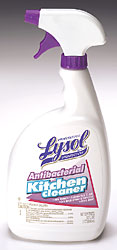Michael McCain, president of Maple Leaf Foods, told a press conference yesterday that continuing to find listeria in the plant responsible for producing luncheon meats that have killed 26 and sickened 63 in Canada was no biggie.
“To suggest a shock at a positive environmental test is at best misguided and at worst fear mongering.”
 As Toronto’s Globe and Mail reported this morning,
As Toronto’s Globe and Mail reported this morning,
When the company’s deli meats were first linked to an outbreak of the food-borne disease known as listeriosis last August, it was a humble Mr. McCain who stood before television cameras and reporters and apologized.
Yesterday, by contrast, he defiantly reproached those who have criticized Canada’s food-safety watchdog, including the media, accusing them of undermining the public’s confidence in the system and of potentially jeopardizing thousands of jobs.
“There’s been a lot of criticism of the [Canadian Food Inspection Agency] in recent weeks,” he said. “While there’s likely lots of blame to go around, I personally see no balance in the reporting.” …
He said it is unrealistic for the public to have zero tolerance for the bacteria because it is everywhere in the environment.
“Frankly, if that was the tolerance level of Canadians, then Canadians would starve. They wouldn’t eat.”
Mr. McCain, this isn’t gotcha journalism and you’re not Sarah Palin. Yes, you have finally released some test results — four out of 3,850 product samples and one environmental sample out of 671 tested positive for listeria in product that was never released to the public – but you refuse to release results prior to public notification of the outbreak.
Yes, this is the most scrutinized plant in North America. Apparently more inspectors, even with listeria goggles, won’t make the listeria go away. The political opportunism being practiced by the inspector’s union and various parties falling over themselves to promise the hiring of more inspectors in the lead-up to Canada’s federal election on Tuesday is breathtakingly offensive to the sick and dead – I think I just threw up a bit in my mouth.
 And yes, the risk is small — Mansel Griffiths, an adviser to Maple Leaf, said the tiny fraction of products that tested positive, 0.1 per cent, was in the range that would be found in deli meats for sale in Canada, ranging from 0.1 to .03 per cent – but I’m sure glad you’re not advising pregnant women, like my wife, who are 20 times more susceptible to infection with listeria – a bug that has a 20-30 per cent kill rate.
And yes, the risk is small — Mansel Griffiths, an adviser to Maple Leaf, said the tiny fraction of products that tested positive, 0.1 per cent, was in the range that would be found in deli meats for sale in Canada, ranging from 0.1 to .03 per cent – but I’m sure glad you’re not advising pregnant women, like my wife, who are 20 times more susceptible to infection with listeria – a bug that has a 20-30 per cent kill rate.
Now that Mr. McCain is a listeria expert, telling Canadians to get over it, listeria happens, I wonder why he never issued such a warning about the risk of listeria in his products before 26 were killed. Would he serve cold cuts to the elderly in nursing homes where many of the 20 confirmed deaths occurred? What would he recommend to one of his pregnant family members? That listeria happens?
In response to the initial coverage of Mr. McCain’s statements yesterday, Carl, a former USDA guru e-mailed me, stating,
“Ummm, maybe someone ought to point McCain to Nebraska’s series of webinars. It’ll take more than the webinars but it could be a start. Eliminating listeriae in plants has been done but it takes effort and diligence not just whining.”
Here’s the info for the latest listeria webinar from Nebraska.
Free Web Seminars on Controlling Listeria monocytogenes on Ready-to-Eat Meat and Poultry Products and in the RTE Processing Environment
The Listeria monocytogenes is a foodborne pathogen and is most often transmitted through ready-to-eat (RTE) foods products contaminated with this pathogen. People at most risk for illness and infection due to this pathogen are young, elderly and those will weakened immune systems such as the immuno-compromised.
The USDA-FSIS requires the Ready-to-Eat (RTE) meat and poultry processors to control Listeria monocytogenes in the environment and on their products. The web-seminar is designed to help small and very small RTE meat and poultry businesses to address Listeria in their RTE environment and ways to reduce the Listeria risk in their products. The web-seminar is designed to update you and provide you an opportunity to ask questions and get answers from the experts.
The University of Nebraska along with its collaborating partners, Colorado State University, Cornell University, Kansas State University and The Ohio State University is conducting a series of free web seminars to inform and educate the RTE meat and poultry processors on various aspects of controlling the organism in the RTE processing environment and on the product. This web seminar series is funded through a grant from the National Integrated Food Safety Initiative (Special Emphasis Grant No. 2005-511110-03278) of the CSREES, U.S. Department of Agriculture.
The next session is scheduled for Oct 15, 2008 from 11:00 AM to 12:00 PM (CST). Those interested can participate in these free web seminars by logging in at the following website:
http://connect.extension.iastate.edu/nebraska/ ??????
To receive notifications and presentation materials ahead of the web seminar, please register by sending an e-mail to Nina Murray at nmurray2@unl.edu with your name and e-mail. ??????
Topic: L. monocytogenes Control Strategies: Quality Effects on RTE Meat Products ???Speaker: Dr. Dennis Burson, University of Nebraska ??????
Dr. Dennis Burson is a Professor of meat science in the Department of Animal Science at the University of Nebraska, Lincoln. He also serves as the Extension meat specialist for the state of Nebraska and assists the meat, poultry and egg industry with outreach activities. He received his B.S. degree from University of Nebraska and his M.S. and Ph.D. degrees from Kansas State University. His outreach focus is on improving quality, consistency and value of market animals, value addition and processing of meat products and food safety for meat and poultry processors. Dr. Burson has conducted numerous meat processing, harvesting and quality workshops in addition to food safety workshops including HACCP for the meat and poultry industry over the years and still is very active in the food safety outreach programs. He coordinates the four state consortium of Universities (UNL, KSU, SDSU, and Missouri) and holds several HACCP workshops within each of the states every year. He has taught several courses, including animal and carcass evaluation, principles of meat evaluation, grading and judging and advanced meat grading and evaluation. Dr. Burson is active in several professional organizations, including American Meat Science Association, Institute of Food Technologists and International Association for Food Protection among others. ??????
Topic: Tracking Listeria in the RTE Meat and Poultry Processing Environment: DNA Based Methods ???Speaker: Dr. Kendra Nightingale, Colorado State University ??????
Kendra Nightingale is originally from a small farming community in western Kansas. Kendra received a B.S. degree in Agriculture from Kansas State University, where she participated in the undergraduate honors program. Kendra also holds a M.S. degree from Kansas State University in Food Science, where her research evaluated the use of lactoferrin, a milk-derived protein, to decontaminate and extend the shelf-life of beef products. Kendra Nightingale completed her Ph.D. at Cornell University in Food Science with a concentration in Food Microbiology and minors in Epidemiology and Microbiology. Her Ph.D. work probed the molecular epidemiology, ecology, and evolution of the human foodborne and animal pathogen Listeria monocytogenes. Kendra also completed her postdoctoral training in the Department of Food Science at Cornell University. Kendra joined the Department of Animal Sciences at Colorado State University as an Assistant Professor in 2006.
 I also have no doubt she would kill a cat for practicality.
I also have no doubt she would kill a cat for practicality.
 they thought at first it was just a run-of-the-mill stomach upset and waited for it to run its course.
they thought at first it was just a run-of-the-mill stomach upset and waited for it to run its course..jpg) The ministry said the deaths – four in Austria and two in Germany – occurred last year and were caused by listeria, an organism that can cause serious and sometimes fatal infections in young children, frail or elderly people and others with weakened immune systems.
The ministry said the deaths – four in Austria and two in Germany – occurred last year and were caused by listeria, an organism that can cause serious and sometimes fatal infections in young children, frail or elderly people and others with weakened immune systems. In fall 2000, I contacted Procter & Gamble to ask for the data substantiating the claim that Fit would eliminate 99.9 per cent of bacteria on fresh produce,
In fall 2000, I contacted Procter & Gamble to ask for the data substantiating the claim that Fit would eliminate 99.9 per cent of bacteria on fresh produce, To cite a 99.9% fatality rate, manufacturers don’t have to kill 99.9% of all known bugs. Regulations don’t require them to disclose which bugs they exterminate, just that the products are effective against a representative sample of microbes. For instance, many products can’t kill Clostridium difficile, a gastrointestinal scourge, or the hepatitis A virus, which inflames the liver. Yet by killing other, more common bugs, they can claim 99.9% effectiveness.
To cite a 99.9% fatality rate, manufacturers don’t have to kill 99.9% of all known bugs. Regulations don’t require them to disclose which bugs they exterminate, just that the products are effective against a representative sample of microbes. For instance, many products can’t kill Clostridium difficile, a gastrointestinal scourge, or the hepatitis A virus, which inflames the liver. Yet by killing other, more common bugs, they can claim 99.9% effectiveness. Funeral arrangements were being made today for Brant Burton, 4, who died Sunday in Wesley Regional Medical Center in Wichita.
Funeral arrangements were being made today for Brant Burton, 4, who died Sunday in Wesley Regional Medical Center in Wichita. As
As  Braylee’s father, Jake Beaver, said after her 12-day hospital stay (family hoto from
Braylee’s father, Jake Beaver, said after her 12-day hospital stay (family hoto from  When asked about compensation for cheese retailers who had to discard potentially contaminated product,
When asked about compensation for cheese retailers who had to discard potentially contaminated product,  Producers and retailers reported a significant drop in sales of Quebec cheeses, which last year alone totaled $2.6-billion.
Producers and retailers reported a significant drop in sales of Quebec cheeses, which last year alone totaled $2.6-billion.(1)(1).jpg) In Ohio, a
In Ohio, a